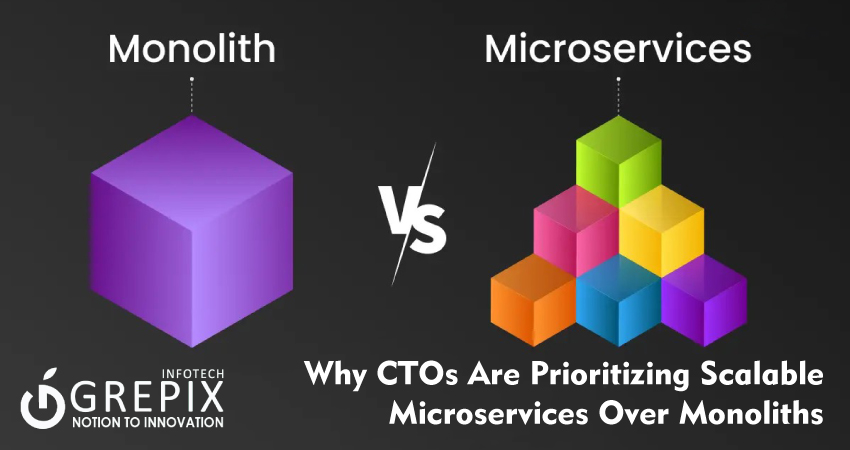Why CTOs Are Prioritizing Scalable Microservices Over Monoliths
In the rapidly evolving digital economy, agility, scalability, and innovation are no longer luxuries—they are survival requirements. CTOs across industries are rethinking their software architectures, moving away from monolithic systems and embracing scalable microservices.
The reason is simple: monoliths are rigid and difficult to scale, while microservices architectures give businesses the flexibility to innovate faster, scale seamlessly, and maintain resilience. By 2025, more than 80% of enterprise applications are projected to run on microservices and containerized environments, according to Gartner.
This article explores why CTOs are prioritizing microservices over monoliths, how this shift impacts product development, and what companies must do to succeed in a cloud-native, API-driven world.
CTOs are increasingly prioritizing microservices over monoliths due to their scalability, resilience, and ability to accelerate innovation. While monolithic systems once served enterprises well, they are now seen as rigid and difficult to scale. Microservices, by contrast, allow independent scaling of services, faster deployments, and greater reliability. Real-world adopters like Netflix, Amazon, and Uber prove how microservices support global operations at scale. For CTOs, the move is not just technological but strategic—aligning architecture with business outcomes like agility, customer experience, and cost optimization. Despite challenges in complexity, observability, and data consistency, solutions like Kubernetes, DevOps automation, and service meshes make microservices manageable. The future lies in AI-assisted, event-driven microservices that make enterprises more adaptive and competitive. Simply put, microservices are the backbone of modern digital business, enabling CTOs to drive growth and innovation at scale.
Understanding Monoliths vs. Microservices
Before diving into why microservices are gaining traction, let’s revisit the fundamental difference between these two architectures.
Monolithic Architecture
- A single, tightly coupled codebase.
- All features (UI, business logic, data access) live inside one application.
- Scaling requires deploying the entire application, even for small updates.
- Example: Traditional ERP systems or legacy banking applications.
Microservices Architecture
- A collection of independent, loosely coupled services.
- Each service owns its own database and runs independently.
- Services communicate via APIs or message brokers.
- Example: Netflix, Amazon, Uber, and modern SaaS platforms.
Why CTOs Are Moving Away from Monoliths
For decades, monoliths were the default choice. They worked well when applications were smaller, teams were centralized, and scalability demands were modest.
But as user bases exploded and businesses expanded globally, monoliths started creating bottlenecks:
1 Scaling Challenges
- You can’t scale a single feature; you must scale the entire application.
- Results in wasted resources and high cloud costs.
2 Slow Release Cycles
- Small changes require redeploying the whole application.
- Increased risk of breaking critical features.
3 Team Bottlenecks
- Large codebases become difficult to manage.
- Multiple teams stepping on each other’s toes.
4 Limited Resilience
- A single bug or crash can bring down the entire system.
For modern CTOs, these limitations are unacceptable in a world where speed, customer experience, and uptime directly impact revenue.
Why Microservices Are Winning in 2025
CTOs are prioritizing scalable microservices because they align with the modern enterprise’s need for speed, scale, and reliability.
1 Scalability on Demand
- Each microservice can be scaled independently.
- Example: During holiday shopping, the “checkout service” scales without overloading the entire app.
2 Faster Time to Market
- Teams can develop, test, and deploy services independently.
- Enables parallel development and continuous delivery.
3 Resilience and Fault Isolation
- If one service fails, the rest continue to operate.
- Improves uptime and customer trust.
4 Technology Flexibility
- Different services can use different programming languages or databases.
- Enables CTOs to adopt the best tech stack for each problem.
5 Cloud-Native Advantage
- Microservices work hand-in-hand with Kubernetes, containers, and serverless.
- Ideal for hybrid and multi-cloud environments.
Real-World Examples of Microservices Adoption
1 Netflix
- Runs thousands of microservices handling billions of API calls daily.
- Scaling is seamless for millions of concurrent users worldwide.
2 Amazon
- Each service—recommendations, payments, orders—is independent.
- Enabled Amazon to become a global leader in eCommerce.
3 Uber
- Transitioned from monolith to microservices to manage ride requests, driver matching, payments, and real-time maps independently.
4 Spotify
- Uses microservices for playlist management, music streaming, and user recommendations.
These examples highlight why CTOs consider microservices not just a trend but a necessity for growth.
Key Business Benefits for CTOs
CTOs are responsible for aligning technology with business outcomes. Microservices offer:
- Agility: Faster response to market demands.
- Scalability: Supports hypergrowth without rewriting systems.
- Innovation: Teams can experiment and release new features quickly.
- Cost Efficiency: Optimized resource usage reduces cloud expenses.
- Global Expansion: Supports distributed teams and global infrastructures.
Challenges of Microservices (and How CTOs Handle Them)
While microservices are attractive, they come with challenges:
1 Complexity in Management
- Hundreds of services mean more moving parts.
- Solution: Use Kubernetes and service meshes (Istio, Linkerd).
2 Observability Issues
- Logs, metrics, and traces are spread across services.
- Solution: Adopt observability platforms like Datadog, Grafana, or Dynatrace.
3 Data Consistency
- Each service manages its own database.
- Solution: Implement event-driven architectures with Kafka or RabbitMQ.
4 Cultural Shift
- Teams must adopt DevOps and SRE practices.
- Solution: Invest in upskilling and cross-functional collaboration.
Despite these challenges, the long-term ROI of microservices outweighs the initial complexity.
Microservices + DevOps = The Perfect Match
Microservices architecture thrives when combined with DevOps automation.
- CI/CD Pipelines: Automate testing and deployment of services.
- Infrastructure as Code (IaC): Manage microservices at scale with Terraform/Ansible.
- AIOps & Observability: AI-powered monitoring for proactive incident response.
CTOs who integrate DevOps and microservices achieve faster releases, higher resilience, and reduced downtime.
The Future: Event-Driven, AI-Assisted Microservices
By 2025 and beyond, the next wave of microservices will include:
1 AI-Assisted Pipelines
- AI predicts failures and auto-scales microservices.
2 Event-Driven Architectures
- Real-time responses powered by Kafka, Pulsar, and serverless functions.
3 Security-First Microservices
- DevSecOps automates compliance and vulnerability detection.
4Composable Enterprises
- Businesses treat microservices like “Lego blocks,” assembling new applications quickly.
Conclusion
For CTOs, the choice between monoliths vs. microservices is no longer a debate it’s a strategic decision that directly impacts growth, customer experience, and competitiveness.
While monoliths still serve small applications well, global enterprises and high-growth startups are prioritizing scalable microservices to stay ahead in a cloud-native, digital-first economy.
By embracing microservices, CTOs unlock scalability, resilience, faster innovation, and cost optimization. Yes, challenges exist, but with the right tools, DevOps practices, and cultural shift, microservices are the foundation of the modern enterprise.
The future is clear: Microservices are not just an architectural choice—they are a business enabler.
FAQs
1. Why are monoliths difficult to scale?
Because scaling requires redeploying the entire system, even if only one feature needs more resources.
2. What is the biggest advantage of microservices?
Independent scalability and resilience—one service can fail without crashing the whole system.
3. How do AI pipelines differ from traditional CI/CD?
AI pipelines can predict failures, auto-scale, and provide proactive fixes, unlike manual CI/CD.
4. Which tools support AI in DevOps?
Popular tools include Jenkins AI plugins, Dynatrace, Datadog, New Relic, and Azure DevOps with ML.
5. Is AI replacing DevOps engineers?
No, AI is augmenting engineers by automating repetitive tasks and allowing them to focus on innovation.
Launch your vision with our mobile app development company, where innovation meets excellence to create cutting edge mobile solutions."







